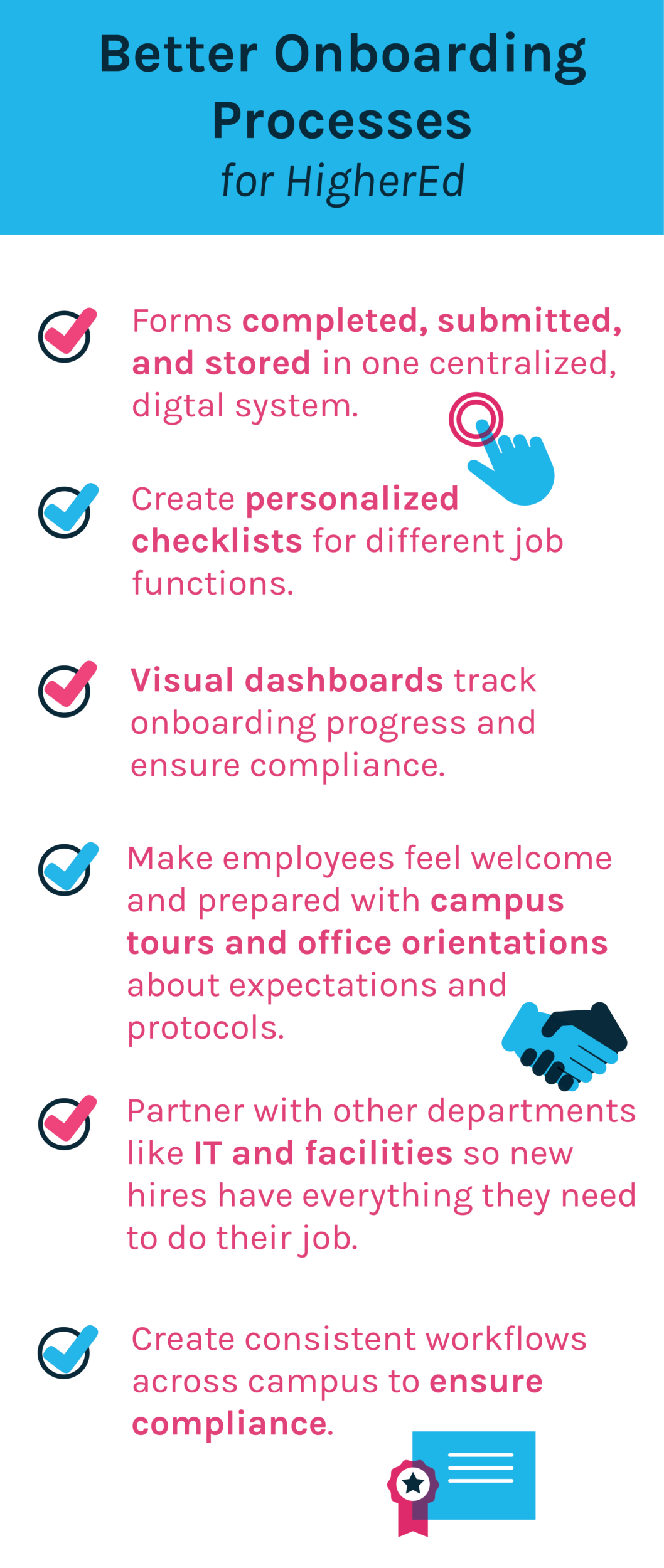What is the Onboarding Process in Higher Education?
If you’re on a human resources team at a college or university thinking about hiring and retention, you should be asking: what is onboarding, and how is it different in the world of higher education?
Onboarding is a vital step of the recruitment and hiring process. The onboarding process is not just an opportunity for new hires to fill out paperwork, but to acclimate to your campus culture and to learn knowledge vital to their roles.
Whether you are onboarding employees in person or remotely, it’s important to have a consistent, engaging, and inclusive process.
Why is onboarding important?
Onboarding is an important factor in employee engagement and retention. SHRM notes that 31% of new hires will leave a role within six months, meaning that the time and money your team invested in hiring them has little ROI. Onboarding can change all that—in fact, a great onboarding program can improve retention by 82%. Still, colleges and universities haven’t historically prioritized onboarding. This means, according to Andrea Brown, director of HR services at the University of Utah, that “new employees often don’t get enough guidance.”
Even where there is a clear and consistent onboarding program, 58% of organizations say their program is focused on processes and paperwork and only 29% of new hires feel prepared for their role after onboarding.
So, what is onboarding?
It’s clear that a consistent and engaging onboarding program is an important factor for increasing employee satisfaction, retention, and success—but what does onboarding consist of? Onboarding begins the moment an employee is hired and should consist of several different aspects.
 1. Paperwork and documents.
1. Paperwork and documents.
When someone newly joins your organization, there is a lot of information your team needs from them. Make sure they get the chance to fill out federally required documents, including I-9, W-4, state tax forms, direct deposit forms. Ensure that they fill out all internal forms, like employee handbook acknowledgements, confidentiality or security agreements, technology agreements, or training acknowledgements. They should also complete benefits enrollment paperwork and provide emergency contacts information.
Most paperwork should be filled out either before an employee’s first day or within the first few days of employment. Don’t be misled when we say paperwork: most, if not all, of these documents can – and should – be delivered, filled out, and signed electronically, eliminating paper documents and ensuring that employee information is stored securely and accurately in one centralized system. Digitized onboarding also helps HR teams ensure nothing gets missed, with clear checklists for HR and for new hires and automated reminders for missing forms.
2. Institutional culture.
The second important part of the onboarding process is introducing a new hire to your campus culture. This aspect of onboarding isn’t limited to the first day or week, but it can be helpful to embrace and engage new hires with your team right away.
If your employee is in-person, offer a campus tour, a department or team lunch, and an office orientation about expectations and protocol (like work hours and attire). For a remote employee, a virtual campus tour, full-team zoom, and written office orientation might be good substitutes.
Many organizations assign mentors to new hires to help them navigate their first weeks, months, or year at a new role—this can be a great offering if your team has the resources, because mentor programs promote engagement, professional development, and retention. Acclimation to company culture is also vital in increasing productivity, and an extended mentor program can give employees the opportunity to continue asking questions and learning beyond the initial orientation period.
New hire productivity is only 25% in the first month and 50% in the second month of employment—it takes a while for a brand-new employee to feel confident and comfortable in a work environment.
3. IT and job functions.
Another important aspect of onboarding is everything technical and job-function related.
Coordinate with IT and facilities so your new team member will have the technology they need to do their job – they might need internet access, an employee email, a computer, a desk, and access to other systems, apps, and tools your team uses.
Make sure to educate them on their work and performance expectations as well. Go beyond the job description to ensure a new hire understands their daily requirements.
4. Have fun.
Don’t forget that onboarding is the first experience your new hire has at your institution! Embrace your new team member and show them how excited you are that they’re joining you.
Is HigherEd onboarding different?
HigherEd onboarding is unique in a few ways. First, HigherEd HR teams often need to design unique onboarding experiences for the vastly different job functions present at most institutions (like full-time faculty, part-time faculty, staff, and even student workers).
Faculty often join an institution at set times, like the beginning of a semester, so it can be simple to set up a new faculty orientation for large groups. It can be more difficult to make staff feel like a fully connected part of an institution, since they might join throughout the year. Some institutions design separate student worker orientations as well, geared towards professionalism or specific work-study rules and expectations.
Onboarding compliance in HigherEd
Onboarding compliance is essential for HigherEd institutions, especially for institutions that depend on state or federal funding. Every state and institution may have their own standards and requirements, and it’s vital that your process adheres to those requirements.
A standardized onboarding process, with clear HR visibility and oversight, ensures that the correct steps are followed every time. Onboarding checklists and automatic notifications through a centralized, digital system like PeopleAdmin’s Employee Records means that no contracts or forms are missed, and all information is stored securely. This also means that your HR team will be audit-ready with accurate, thorough historical records when the time comes.

Simplify and streamline with PeopleAdmin
PeopleAdmin’s Employee Records supports colleges and universities with onboarding processes and helps tackle challenges unique to HigherEd. A modern, digitized onboarding process welcomes new hires, gets them up to speed quickly, and keeps them engaged, all while ensuring HR compliance.
Seamless integration with Applicant Tracking System means applicant information carries over into the onboarding process, while digital form management extends throughout the employee lifecycle and ensures that everything is in one place, reducing data re-entry.
Employee Records can make a difference for your team.
- Personalized onboarding. The Employee Records portal is customizable and flexible. HR teams can create unique workflows and checklists that support different job functions, and departments can add meaningful, development-driven activities specific to each role.
- Reduce time-to-contribution. A seamless and streamlined onboarding process means less time spent on paperwork. And with more institutional and job function training, new employees get up to speed quicker so they can start furthering your mission.
- Administrative oversight. HR oversight, user-friendly reports, and visual dashboards help your team track onboarding progress, reduce bottlenecks, and ensure compliance across campus.
- Security and compliance. When all documents are completed, submitted, and stored in one portal, sensitive information stays secure. No more emails, attachments, or missing pieces of paper.
- Integrations. Seamless integrations mean you can complete I-9 verification with just a few clicks. Employees won’t have to submit documents in multiple places, and you’ll still get the information you need.
Onboard better and faster.
The right onboarding solution will increase retention and engagement, reduce your cost-per-hire, and make sure your new hires are contributing to your institutional mission. PeopleAdmin’s Employee Records offers the HigherEd-specific functions you need to take your onboarding to the next level.
Thank you. A PeopleAdmin representative will contact you shortly.